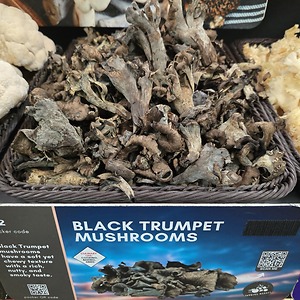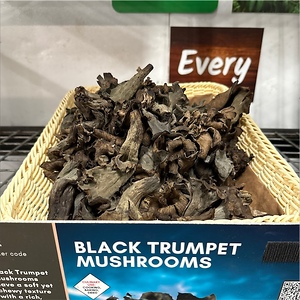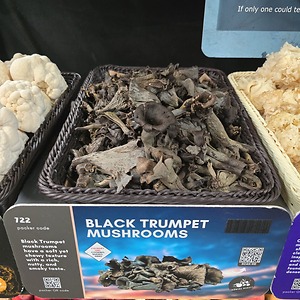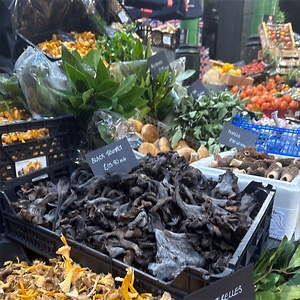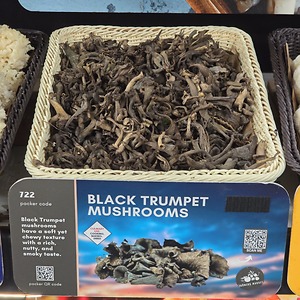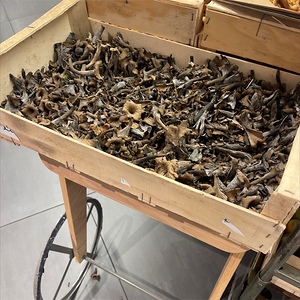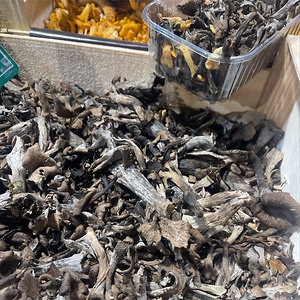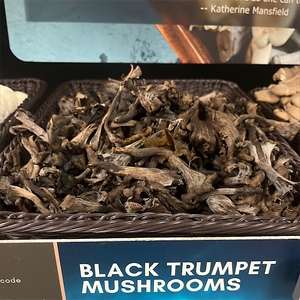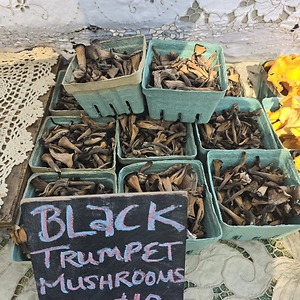


Black Trumpet Mushrooms
Estimated Inventory, lb : 0
This item was last sold on : 05/06/25
Description/Taste
Black Trumpet mushrooms are small in size, averaging 3 to 5 centimeters in diameter and 5 to 9 centimeters in height, and vary in appearance, depending on the specific species and maturity at harvest. Young Black Trumpet mushrooms are tubular, opening into a tapered, funnel or vase-like shape. The edges of the mushroom also begin tightly rolled under, partially unrolling with maturity and developing a slightly wavy, curled look. The mushroom is known for lacking a clearly defined cap and stem, and the underside does not feature true gills. Some Black Trumpet mushrooms have a smooth underside, while others will bear wrinkles and folds, giving them a light texture. Black Trumpet mushrooms range in color from brown, black, tan, to grey, and the skin is thin, smooth, and paper-like with a suede feel. Thin, partially flaky scales also form on parts of the mushroom’s surface. In the center of the mushroom is a hollow funnel extending the entire fruiting body. Black Trumpet mushrooms emit a distinctly fruity, woody, and earthy aroma that can be infused into dishes and have a delicate, subtly chewy, and tender consistency. The mushrooms are edible raw in small quantities but are preferred cooked to develop a slightly sweet, rich, nutty, and smoky taste with stone fruit-like nuances. Some species of Black Trumpet mushrooms also impart a bitter note, depending on how they are cooked.
Seasons/Availability
Black Trumpet mushrooms are typically foraged from early summer through winter, varying with each growing region.
Current Facts
Black Trumpet mushrooms, botanically a part of the Craterellus genus, are a category of several species belonging to the Cantharellaceae family. The wild mushrooms are found in forests worldwide, especially in Europe and North America, and are seen growing individually or in large groupings. Black Trumpet mushrooms are divided into regional species, with Craterellus cornucopioides being the most common type in Europe and Craterellus fallax being the predominant species in North America. It is important to note that many other Craterellus species are also generally sold under the Black Trumpet name. Black Trumpet mushrooms form mycorrhizal relationships with hardwood trees, meaning they share a mutually beneficial exchange of nutrients to survive. The mushrooms are found on the ground in forests and are challenging to spot as they typically blend in with fallen debris and soil. Foragers favor Black Trumpet mushrooms as they have no poisonous look-alikes and bear a distinct flavor and aroma valued for culinary purposes. Black Trumpet mushrooms are a seasonal foraged delicacy sold under names like Horn of Plenty, Black Chanterelles, Devil’s Trumpet, Horn of Death, and Trumpet of the Dead. Chefs and home cooks select varieties for their complex flavoring, unusual coloring, and rich, umami-forward nature. The mushrooms can be used in a wide array of sweet or savory culinary preparations.
Nutritional Value
Black Trumpet mushrooms are a source of fiber to aid digestion and vitamins B, C, and K to assist with energy production, strengthen the immune system, and support faster wound healing. Mushrooms also provide minerals like potassium, magnesium, phosphorus, calcium, and iron. Potassium balances fluid levels within the body, while magnesium controls nerve functions. Calcium and phosphorus help with bone and teeth development, and iron produces the protein hemoglobin for oxygen transport through the bloodstream. Mushrooms also contain antioxidant and anti-inflammatory properties to help maintain overall bodily health.
Applications
Black Trumpet mushrooms have a rich, fruity, and earthy flavor suited for cooked preparations. The mushrooms can be eaten raw in small quantities, but most foragers and sources recommend cooking them to enhance their nuances. Black Trumpet mushrooms must be lightly cleaned with a brush or rinsed to remove dirt and debris, and the thin funnel can be gently sliced open to access the interior. Once cleaned, the mushrooms cook quickly and shrink in size, so consideration should be taken when incorporating them into recipes. Most chefs like making Black Trumpet mushrooms the stars of dishes and do not cook them with other mushrooms, as they can be easily lost in mixes. Black Trumpet mushrooms shine when heated in cream-based sauces or egg dishes. Try adding them to soups and stews or combining them with rice and couscous. They can also be incorporated as a pizza topping, tossed into pasta dishes, or lightly battered and fried. Black Trumpet mushrooms are enjoyed fresh and dehydrated for extended use. When dried, the mushrooms can be ground into a powder and added to sauces and soups, or used in fillings for savory pies and tarts. Black Trumpet mushrooms pair well with herbs like chives, thyme, sage, and spearmint, celery, leeks, peas, carrots, meats such as salmon, pork, beef, rabbit, or poultry, and eggs. Whole, unwashed Black Trumpet mushrooms will keep for 2 to 3 days when stored in a paper bag in the refrigerator. It is recommended to use the mushrooms immediately after purchase for the best quality and flavor, but they can also be dried for prolonged storage.
Ethnic/Cultural Info
In Europe, Black Trumpet mushrooms are known by several unusual names and nicknames. The mushroom’s distinct flavor and natural availability earned it the moniker "the poor man's truffle.” When cut into small pieces or dehydrated and ground into flour, the mushroom’s flavor and dark appearance somewhat resemble the more expensive truffles, and it is sometimes used as a substitute. Black Trumpet mushrooms are also called the Trompette De La Mort and Trombetta Dei Morti in French and Italian, meaning “Trumpet of the Dead.” Legend has it that this name is derived from the mushroom’s arrival in forests around All Saints’ Day, an annual celebration on November 1st. In France, All Saints’ Day is a time when families honor the memory of ancestors who have passed. Families visit gravesites and place flowers, plaques, and candles as an act of remembrance. The name Trumpet of the Dead correlates to a local superstition that the mushrooms appear as trumpets for the deceased so they could play music only the dead could hear underground.
Geography/History
Black Trumpet mushrooms are native to deciduous forests worldwide, depending on the specific species, and have been growing wild since ancient times. Several species have origins in Europe, Asia, the Americas, and Australia, and develop symbiotic relationships with the roots of trees like Beech, Oak, and Madrone. Historically, Black Trumpet mushrooms have remained primarily a wild species and are seasonally foraged as a culinary delicacy. Efforts are being made to cultivate the mushrooms, but most fungi sold in commercial markets are foraged from wild populations. Today, Black Trumpet mushrooms are somewhat challenging to find in the wild due to their camouflaged nature. They are offered through local markets and select wholesalers worldwide.
Recipe Ideas
Recipes that include Black Trumpet Mushrooms. One
Podcast



